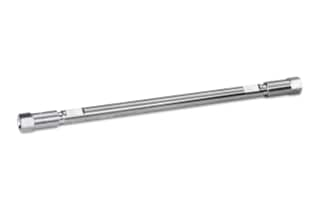
Delta-Pak packings are based on a highly stable, bonded, endcapped 5µm or 15µm spherical silica. Delta-Pak is available in two different pore sizes (100Å and 300Å) with either C4 or C18 bonded phase. Delta-Pak packings are available in different cartridge and column configurations, providing consistent and predictable scale-up capabilities for milligram-to-gram scale purification. Also, by having the same chemistry available on a high-efficiency 5µm particle, you can easily check the purity of your fractions.
|
Chemistry |
C18 |
|
Separation Mode |
Reversed Phase |
|
Particle Substrate |
Silica |
|
pH Range Min |
2 pH |
|
pH Range Max |
8 pH |
|
Maximum Pressure |
6000 psi (415 Bar) |
|
Endcapped |
Yes |
|
Silanol Activity |
Low |
|
Molecular Weight Range Min |
1000 |
|
Molecular Weight Range Max |
15000 |
|
Particle Shape |
Spherical |
|
Particle Size |
5 µm |
|
Endfitting Type |
Waters |
|
Pore Size |
100 Å |
|
Format |
Column |
|
System |
HPLC |
|
USP Classification |
L1 |
|
Inner Diameter |
3.9 mm |
|
Length |
150 mm |
|
Carbon Load |
17 % |
|
UNSPSC |
41115709 |
|
Brand |
Delta-Pak |
|
Product Type |
Columns |
|
Units per Package |
1 pk |

Delta-Pak C18 Column, 100Å, 5 µm, 3.9 mm X 150 mm, 1K - 15K, 1/pk
Make use of the Delta-Pak C18 Column in your lab to undertake the isolation and analysis of synthetic peptide mixtures. The packings that are present in the Delta-Pak C18 Column are based on a very stable, bonded, end-capped spherical silica and are well suited for the separation of peptides, proteins, and natural products. In addition to this, for milligram-to-gram scale purification, the lab equipment offers consistent and predictable scale-up capabilities. By having the same chemistry available on a high-efficiency 15m particle, you can readily check the purity of your fractions.
Simply opt for the use of the Delta-Pak C18 Column, where the application requires a hydrophobic material because the Delta-Pak material is highly hydrophobic. Count on the Delta-Pak C18 Column to solve challenges associated with commonly available silica columns, such as inconsistent column performance, unexpected column lifetimes, sample loss and waste, recurring purification operations, and inadequate scalability from small to big volume columns.
The Delta-Pak C18 Column packing material is made in a cGMP, ISO 9001 certified plant utilizing ultra-pure reagents, just like all our lab equipment. Additionally, each batch is chromatographically tested to confirm product quality, and the results are restricted to narrow specification ranges to ensure great, repeatable performance.
After every Delta-Pak C18 Column has been independently tested and in the column box or on the eCordTM Intelligent Chip, a Performance Chromatogram and Certificate of Batch Analysis are included. Each batch of packing material has its own Certificate of Analysis. The batch number, unbonded particle analysis, bonded particle analysis, and chromatographic results and conditions are all included in the certificate. The batch number, column serial number, USP tangent efficiency, USP tailing factor, retention factor, and chromatographic conditions are all included in the Performance Test Chromatogram for each particular column. It is recommended that these data should be saved for future reference, according to the experts. You can request information from our website if you are unable to access the information on the eCord Intelligent Chip, the Certificate of Analysis, or the Performance Test Chromatogram.
We recommend the use of the Delta-Pak C18 Guard Column, 100Å, 5 µm, 3.9 mm X 20 mm, 1K - 15K, 2/pk in order to ensure that your lab equipment lasts a long time and that it continues to deliver optimum performance throughout its lifetime.
What Is The pH Range Of The Delta-Pak C18 Column?
With a working pH range of 2-8, the Delta-Pak C18 Column, as mentioned here, provides versatile compatibility for a wide range of analytical applications. It is important to adhere to this pH range to ensure optimal performance and column longevity. Operating the column within the specified pH range allows for efficient separation, identification, and quantification of target compounds in your samples.